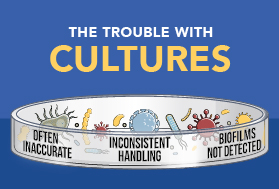The Limitations of Culture
Culture misses microbial species in biofilms

Cell culture methodology cannot identify many of bacterial species present as pathogens in chronic urogenital tract infections. Culture misses microbial species in biofilms, fails to elucidate complex polymicrobial infections, and fails in identifying the full spectrum of antimicrobial resistance factors. In contrast, MicroGenDX qPCR+NGS is capable of providing a more complete microbial infection profile in chronically infected patients. This is why 16S DNA sequencing is increasingly becoming the gold standard in diagnostic technology.
Bacteria adaptation can result in culture ID evasion
Viable but nonculturable (VBNC) – Known uropathogens such as E. coli (including EHEC), K. pneumoniae, E. faecalis, and Pseudomonas aeruginosa are capable of entering and resuscitating from a VBNC state without losing their virulence. During the VBNC state, microbes maintain their cellular structure, biology, and significant gene expression — which allows detection by molecular testing. While in the VBNC state, these pathogens are nonculturable by standard laboratory methods.
E. coli L form, a cell wall-deficient adaption that doesn’t grow under typical culture conditions and can survive cell wall-specific antibiotics, were detected in 29 out 30 rUTI patients.
Biofilm growth increases the fitness of bacteria in harsh conditions, but can exhibit impaired growth in culture, even when the species involved are readily culturable and permissive conditions are used.
Bacteria in biofilm state can escape detection in culture-based sampling
As one example, a culture-impaired variant of Pseudomonas aeruginosa undergoes mutations that alter the bacteria’s outer-membrane lipopolysaccharide structure. Within biofilms, these lipopolysaccharide mutations markedly increase bacterial fitness. However, outside the protected biofilm environment, the mutations sensitize the variants to killing by a self-produced antimicrobial agent.
In this way, biofilm-mediated adaptation produces trade-offs that could limit the ability of bacteria to transition between biofilm growth and the free-living state. This produces bacterial populations that escape detection by culture-based sampling.
Biofilm formation is now recognized as causing or exacerbating numerous chronic infections, including chronic urinary tract infections. The CDC and NIH have estimated that biofilm infections now constitute 65-80% of bacterial infections treated by physicians in the developed world. Read more about biofilms.
C&S understates antimicrobial resistance
Culture has proven inadequate navigating in vivo and in vitro differentiated gene expression, enhanced pathogenicity in polymicrobial colonies, biofilm formation, and drug-resistant subpopulations. These shortcomings often result in unidentified antimicrobial resistance.
Resistance gene expression may be much higher in vivo than in vitro: a transcriptome analysis of P. aeruginosa in human infection and a variety of lab conditions found resistance genes had substantially higher expression in human infection versus culture. In addition, culture may underestimate antimicrobial susceptibility of a polymicrobial infection from two standpoints:
- Culture may flag polymicrobial infections as monomicrobial or dismiss them as contaminants
- Antibiotic sensitivity analysis is performed on single bacteria, not polymicrobial colonies
The relationship between S. aureus and P. aeruginosa is a well-documented instance of how polymicrobial infection can reduce antimicrobial susceptibility. S. aureus can be protected from tobramycin when growing with P. aeruginosa capable of producing Psl, and S. aureus components like SpA can enhance the antimicrobial resistance of P. aeruginosa biofilms.
Biofilms that culture cannot replicate can also dramatically reduce antimicrobial susceptibility due to these factors:
- The limitations of antibiotic diffusion through the biofilm matrix
- Transmission of resistance genes throughout the entire biofilm community
- Physiological changes in microbial cells – such as reduced metabolic and growth rates – due to the nutrient limitations of the biofilm environment
In addition, small heteroresistant subpopulations of cells can replicate in antibiotics despite the majority population being susceptible. Similarly, persister and VBNC cells are drug-tolerant phenotypes whose stress-induced dormant state allows them to survive the presence of antibiotics – after which they can rapidly resuscitate when surrounding conditions improve.
Culture vs. qPCR + NGS from MicroGenDX
| Traditional Culture | MicroGenDX qPCR+NGS |
|---|---|
|
|
|
|
|
|
References
- Sathiananthamoorthy S, Malone-Lee J, Gill K, Tymon A, et al. Reassessment of Routine Midstream Culture in Diagnosis of Urinary Tract Infection, J Clin Microbiol. 2019 Mar; 57(3): e01452-18. DOI: 10.1128/JCM.01452-18
- Pseudomonas aeruginosa transcriptome during human infection, PNAS, 2018.
- G.D. Ehrlich et al. Culture Negative Orthopedic Biofilm Infections, Springer Series on Biofilms 7. 2012. doi.org/10.1007/978-3-642-29554-6_1
- Staphylococcus aureus interaction with Pseudomonas aeruginosa biofilm enhances tobramycin resistance, NPJ Biofilms and Microbiomes, 2017
- Penterman J, Nguyen D, Anderson E, et al. Rapid evolution of culture-impaired bacteria during adaptation to biofilm growth. Cell Reports. 2014 Jan;6(2):293-300. DOI: 10.1016/j.celrep.2013.12.019
